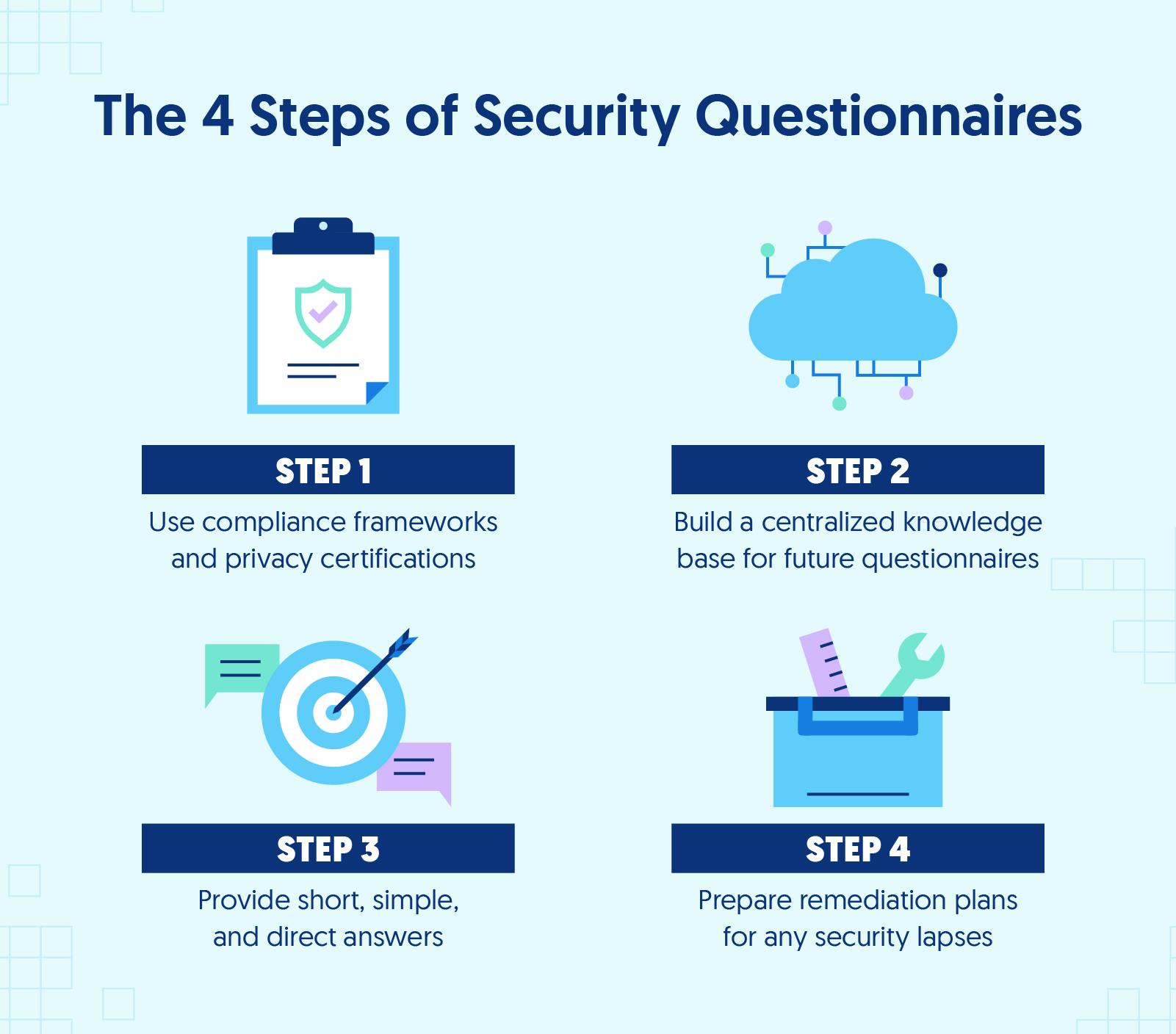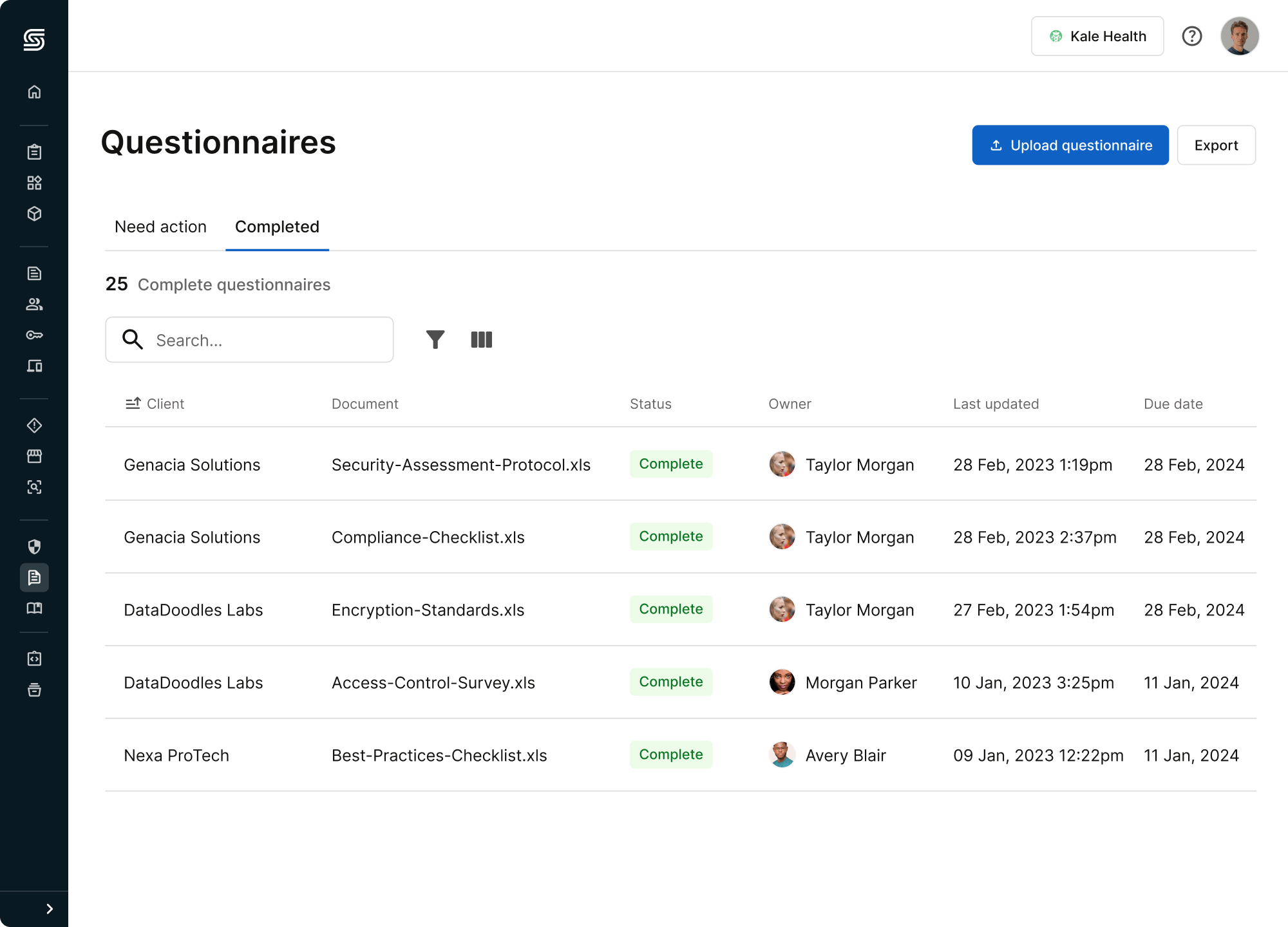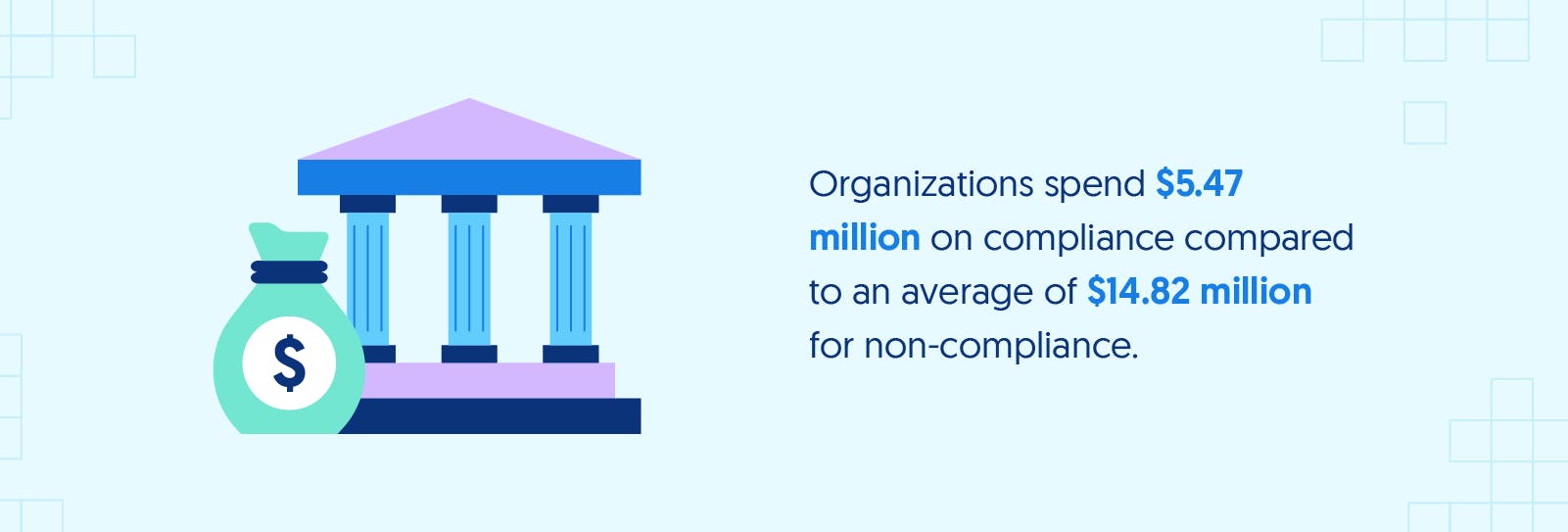
Table of Contents

Senior Content Marketing Manager at Secureframe
Senior Compliance Manager at Secureframe
Security questionnaires are an important part of a company’s due diligence process. When used well, they can help your organization build trust with new prospects. But they can be time-consuming if you don’t have efficient processes in place.
In this guide, we’ll walk you through:
If you need inspiration for sending your own assessment, check out our security questionnaire template.

A security questionnaire is a list of questions that assess your organization’s security and data privacy practices. Organizations often exchange questionnaires before going into business together.
While you can create your own questionnaire to learn about a company’s security posture, there are also standardized questionnaire templates available like the Standard Information Gathering (SIG) questionnaire.
The questions may vary but security questionnaires are a standard part of the third-party risk management process.
Imagine you’re the CISO of a growing SaaS company. You’re about to sign up with your first strategic partner. One day, they send you a list of questions:
“Has your organization ever been compromised?”
“Does your organization use a local firewall?”
“Do you have a data center? Where is it located?”
Congratulations — you’ve received your first security assessment questionnaire. They may appear intimidating, but they can be an invaluable tool for your organization.
Let’s take a closer look at the purpose of a security questionnaire, then walk through the process of answering one so you can close new deals.

Vendor Risk Management (VRM): How to Implement a VRM Program that Prevents Third-Party Breaches
If your IT security or sales team received a security questionnaire, it means that another organization is considering doing business with you. But first, you need to show that your organization can be trusted to protect sensitive data.
Answering assessments can take up valuable time, even more so if you’re receiving multiple questionnaires from a growing list of potential customers.
As your organization grows, you’ll want to have a standardized process for answering questionnaires.

While security questionnaires are an important part of TPRM, the time spent answering them can add up if you’re not strategic.
We’ll walk you through how to use compliance audits and reports to simplify the answering process. For further simplification, we’ll guide you on how to build a knowledge database and keep your answers concise.
If you discover a security gap when answering a questionnaire, don’t worry. We’ll show how that can be a growth opportunity for your organization.
Here’s how to answer a security questionnaire in four easy steps.
Compliance frameworks like SOC 2® or ISO 27001 certifications will prepare your team to address most security questionnaires.
To illustrate how this works, let’s examine preparing for a SOC 2 audit.
To pass you must:
You can save time on future questionnaires by completing the groundwork here.
Tip: Use your certifications to create standardized documentation of your verified data security practices.
You can build a knowledge database when your organization meets the criteria for various compliance frameworks.
As you receive more vendor assessments, log each question and answer into a centralized database. Then you can make a habit of monitoring and updating the knowledge base.
Tip: Reference and repurpose relevant answers from your knowledge base for fast and consistent responses on future assessments.
It’s common for a security assessment to include hundreds of questions. Below are a few things reviewers expect:
Tip: Before answering questions, scan the list for any that are not applicable to your product or service. This can help narrow down the questions you might need to spend more time on by providing further explanation.
Answering each question should also help your organization define its cybersecurity practices. They can even help you uncover any internal security vulnerabilities that could lead to a data breach.
Don’t panic if you uncover a security gap when completing a questionnaire. Instead, you can show your potential business partners that you’re a proactive and transparent organization. Here’s how:
Tip: Keep lines of communication open and your customer informed about how your information security upgrades are going.
Now that you know how to prepare for and answer a security questionnaire, the next step is to create and send your own assessments.
Save hundreds of hours answering questionnaires and RFPs with Secureframe’s machine learning-powered automation.

Organizations can practice continuous compliance by sending security questionnaires. This could also be a competitive advantage for your organization.
According to a Ponemon Institute report, only 49% of organizations vet third-party vendors. Half of your competitors allow vendors access to sensitive information without due diligence.
Sending security questionnaires also makes adhering to data protection regulations less expensive. Research shows non-compliance costs organizations roughly three times as much as compliance. Vetting your potential third-party vendors can literally pay for itself.

When growing your organization, sending questionnaires helps build trust with new business associates. Sending annual assessments shows that you are proactively managing third-party risk. It also signals that you are safe to work with.
There are certain topics your security questionnaire should cover that can help you close more deals.
The content of security questionnaires varies by organization. But they all have the same goal: vendor security. You want to find out if you can trust a prospective service provider to protect your business and customer data. Including the following topics should help you find out.
Asking about security and privacy certifications is a great place to start. See if a potential business associate has any of the following certifications:
These credentials show that your counterpart is maintaining compliance with data protection standards.
It can be simple as asking:
Next you will want to see how a potential vendor handles governance, risk, and compliance (GRC) before entering an agreement. You want to know that your business associate has a strategy for managing risk and maintaining compliance. Are they able to balance GRC while meeting their performance goals?
Here are some good questions to help make that determination:
Organizations that conduct regular internal compliance audits have lower adherence costs. Non-compliance is expensive, so you want to partner with an organization that is always looking for its own compliance gaps.
To find out if your third parties follow continuous compliance, ask about their:
Questions you can ask include:
You may want to understand how an organization protects its network infrastructure to see if there are cybersecurity vulnerabilities or any potential gaps that can be exploited.
Questions you can ask include:
Similarly, you may also want to know how an organization protects its physical infrastructure, including any data centers, workspaces, or facilities. This can help you identify potential weaknesses and threats to assess whether the infrastructure is adequately protected against threats such as burglaries, data breaches, and unauthorized access.
Questions you can ask include:
Now that you’re ready to send your own, here’s how to make the process painless for you and your customer.
Creating an effective security questionnaire is imperative to identifying vulnerabilities posed by third-party vendors. Here are some tips that can help:
Every organization is unique so it’s good practice to reference the following industry-standard questionnaires before building your own:

How to Use SIG Questionnaires for Better Third-Party Risk Management
Rather than building a security questionnaire from scratch, consider using an auditor-reviewed security questionnaire template (like the one below) that lists possible questions covering administrative safeguards to severance of services.

Industry-standard questionnaires and templates cover many of the questions you need to ask to gauge a vendors’ security posture, but they are not enough to defend against the unique risks of your third-party attack surface.
Each questionnaire should contain questions about the unique threats your organization as well as the vendor faces and any compliance requirements that are specific to your or their industry.
Security questionnaires can be a valuable tool in managing third-party risk, but they should not be the only tool. Here are a few reasons why questionnaires are only one potential aspect of an entire third-party risk management program:
For these reasons, effective third-party risk management requires a multi-faceted approach that goes beyond questionnaires. This may include:
.png?auto=format%2Ccompress&fit=max&w=256)
SOC 2 vs Security Questionnaires: What’s the Difference & Which Do You Need?
In conclusion, while security questionnaires can be a valuable component of third-party risk management, they should be part of a broader risk management strategy that includes risk assessments, ongoing monitoring, and collaboration with vendors to mitigate risks effectively.
Secureframe Third-Party Risk Management (TPRM) can help streamline the way organizations handle third-party risks, offering a comprehensive suite of tools to make third-party risk management more efficient than ever. This includes:
Filling out security questionnaires by hand can take hundreds of hours in aggregate each year. They can also be expensive if you need to hire outside consultants and subject matter experts to help you answer detailed questions.
That’s why we built Questionnaire Automation, an AI-powered solution that makes it fast and easy to respond to customer questions and demonstrate your organization’s security posture.
Upload the security questionnaires you receive to Secureframe, then tag the question and answer fields. Our machine learning will fill in the answers. Verify the answers or assign to your internal SMEs to edit details, then export the completed questionnaire in the original format and send it back to your customer.
Now you can easily access answers to security questions from the comfort of your browser with the Knowledge Base Chrome Extension.
Schedule a demo of Secureframe Questionnaire Automation to see it in action, and to learn how our compliance automation platform can streamline your security compliance program.

What is a security questionnaire?
A security questionnaire is a list of questions designed to assess an organization’s security and data privacy practices. By understanding the security posture of third party vendors, organizations can make informed decisions about risks and ensure that partners and suppliers don't introduce vulnerabilities into their environment.
How do you complete a security questionnaire?
When completing a security questionnaire make sure to give accurate, up-to-date answers.
Security questionnaire automation streamlines the process and saves hours of manual work by automatically completing answers to security questionnaires and RFPs based on past responses.
Why are security questionnaires important?
Security questionnaires are an essential part of a strong vendor risk management program:
What is the best security questionnaire automation?
Secureframe’s security questionnaire automation leverages the latest advances in artificial intelligence (AI) and machine learning to pull the best answers for security questions based on past responses, saving hours of manual work completing questionnaires and RFPs